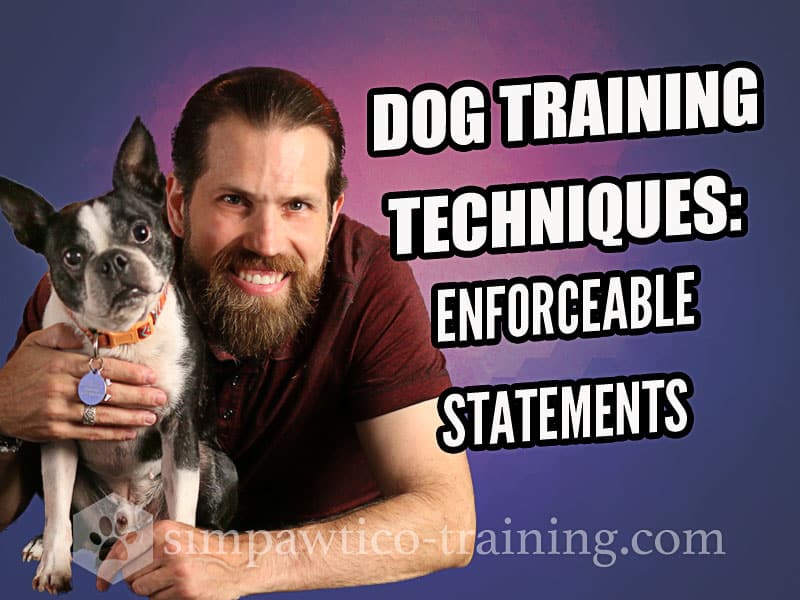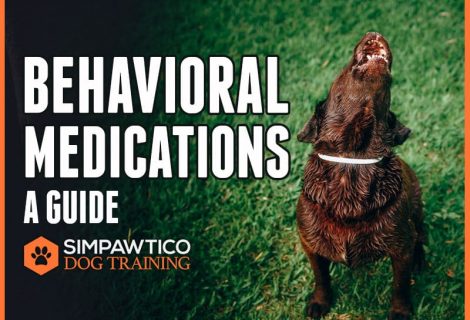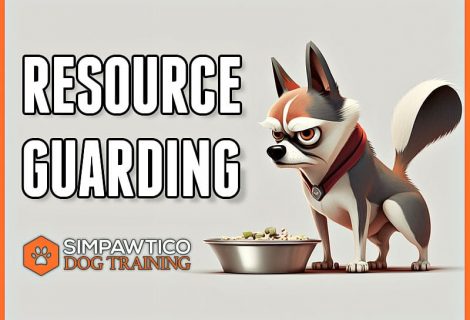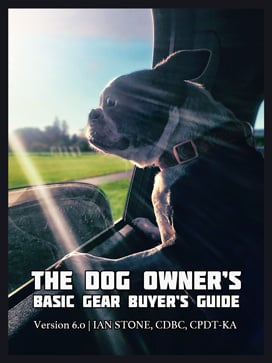How (and Why) to Use Enforceable Statements
Today I want to share with you a strategy that fuses meaningful communication with mindset, called enforceable statements. Don’t forget to check the resources at the bottom for a free download!
LOVE & LOGIC
Enforceable statements have been around for several years. The concept originates from a philosophy called Love and Logic; it’s one of the core strategies taught in it. Although Love and Logic is aimed at parents and teachers, the key strategies apply wonderfully to parenting and teaching our dogs.
Enforceable Statements will help you set and enforce limits while minimizing power struggles. Demands, threats, and warnings don’t do anything effectively.
Besides, you can’t CONTROL another living thing; it’s an illusion. And do you really want “control” like that anyways? I don’t. I want a companion, a family member.
Basically, when you say, “You will…” You’re giving up your power and influence to the dog. When they don’t do what you say, then they’re wrong, you’re frustrated, you feel like a fool, and then you feel like you have to follow up. It’s stressful for both of you! When you say, “I will…” You reclaim your power and influence and put the ball in the dog’s court. Importantly, it gives the dog a chance to correct their own behavior, which is a powerful component to learning. We say what we will do or what we will allow, and then we stick to it.
Your actions will demonstrate what you mean even if your dog doesn’t understand the words. This means you’re saying the words as much for you as for them.
USING ENFORCEABLE STATEMENTS
Here are some examples of ineffective statements followed by the more effective enforceable statement.
Ineffective: “Sit! Sit! Sit!” More Effective: “I will give you your dinner as soon as you sit.”
Ineffective: “Don’t bark at me! Shut up! Be quiet!” More Effective: “I will be happy to walk with you as soon as you’re quiet.”
Ineffective: “You will not stay in this room and act like that!” More Effective: “you may stay with us if you can give up on that behavior.”
Ineffective: “Keep your mouth off of me.” More Effective: “Feel free to hang out with me when you can keep your mouth to yourself.”
Ineffective: “That’s it! Time out for you!” More Effective: “We’ll try again later. I’m going to do something else now.”
Ineffective: “Come here! Come here! COME HERE!” More Effective: “Well, I’m going this way. You can sit there if you like until you’re ready to have fun with me.”
Try out just one or two statements to start. Don’t overwhelm yourself with a complete overhaul of your program. And take a look at the things you’re willing to back up, and don’t worry too much about the rest. It’s ok to acknowledge that our dogs and we are inconsistent.
Now, as I said, your dog, of course, won’t understand all the words. But your dog understands more than you think they do, and the sentiment will be understood. Mainly, though, it gives YOU a framework to operate in. When those statements leave your lips, you’re setting up a cooperative, productive scenario. Now, you need only act on what you’ve said. And therein lies the beauty of this approach: it gives you your next move.
If you just say “Shut up!” what will you do when they don’t shut up? If, instead, you say, “I’ll be happy to walk with you as long as you’re quiet,” then it’s easy…you don’t walk as long as they’re barking. The walk, the thing the dog wants to do, only happens when they move quietly.
As always, you must immediately give the appropriate feedback and reinforcement when the dog offers better behavior.
ONE-LINERS
The Love and Logic philosophy also teaches how to use “One-Liners,” and these complement your enforceable statements. One-liners are great responses when your dog tries to hook you when they’re trying to engage with you. Maybe you’ve asked them to do something and they bark at you. Or you take something away from them, and they have a fit. Or you’re starting some outdoor training, and they’re having a meltdown on the end of the leash.
My favorite one-liners are:
- “I know.”
- “You’re fine.”
- “Are you almost finished?”
- “Let me know when you’re ready.”
One-liners aren’t delivered sarcastically. I’ll admit that’s tough for me because anyone that knows me knows I am a smartass. With dogs, though, I can turn it off and approach from a more sensitive position. Truly productive one-liners come from true compassion. But by design, they keep you from buying into the dog’s behaviors.
All of this ties beautifully into other training strategies like All-or-None Reward Training, Lure Reward Training, Classical Conditioning, and even counterconditioning. It takes patience and a cool head. But if you truly love your pooch, it’s easy to do. Just relax.
SHARING CONTROL
Another reason I like this is because we share some control with our dogs, and we don’t get hooked into controlling things we can’t or don’t need to. Put your energy into the most useful areas.
Now on that note of sharing control, please understand that any time your dog struggles with something or resists or throws a fit, it has NOTHING to do with any of that dominance garbage that’s still everywhere. Listen: every scientific study in the last 20 years on canine behavior and how dogs learn has completely dismantled and discredited the notion of dominance hierarchy. Your dog’s not vying for control or status rank when he leans against you, barks when you say no, or walks ahead of you, or won’t come.
You mustn’t fall into the trap of framing your relationship as adversarial. It’s not; it’s cooperative; it’s a team sport. You’re a human, with a superior brain, and you can accomplish more, in less time, with some sensitivity and patience.
KEY TAKEAWAYS
Here are some key takeaway points for you:
- Commit to do it with an emotionless but compassionate attitude. Don’t get caught up in knee-jerk reactions.
- Be prepared to act. Those “must-do” requests that go unheeded must be followed up on.
- Give yourself a framework for following up with enforceable statements.
- Don’t accept excuses from your dog or yourself.
- Be prepared for a little baby fit or two. It’s OK, just don’t buy into it. You’ll stay calmer, and they’ll figure it out faster.
So give it a try and let me know how this works for you. Let’s connect in the comments and share more ideas, and don’t forget to give the video a thumbs up on YouTube if you learned something useful.
As always, keep learning, keep practicing, and I’ll see you soon!
RESOURCES
Free download of our P-38 Handout (incorporates Enforceable Statements). PDF, 748k
APDT Statement on Dominance and Dog Training
AVSAB Position Statements (specifically on Dominance)
CCPDT warnings against Dominance Theory (spec. #3, “Red Flags”)
What is Love and Logic (from their website)
Enforceable Statements (for parents and teachers, really cool Flash presentation)










Awesome content! A rarely treated topic, explained really clear and structured. Keep on doing this!